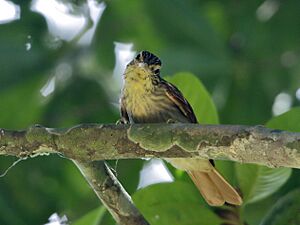Eastern woodhaunter facts for kids
Quick facts for kids Eastern woodhaunter |
|
|---|---|
 |
|
| Conservation status | |
| Scientific classification | |
| Genus: |
Automolus
|
| Species: |
subulatus
|
 |
|
| Synonyms | |
|
|
The eastern woodhaunter (Automolus subulatus) is a type of bird. It is also known as the Amazonian woodhaunter. This bird belongs to the ovenbird family called Furnariidae. You can find it in countries like Bolivia, Brazil, Colombia, Ecuador, Peru, and Venezuela.
Contents
About the Eastern Woodhaunter's Name
Scientists who study birds often group them based on how they are related. The eastern woodhaunter used to be in a different group called Hyloctistes. But new studies showed it actually fits better with the Automolus group.
For a while, scientists debated if this bird was one species or two. They decided to split what was once called the "striped woodhaunter" into two different species. The birds found more to the west became the western woodhaunter. The birds found more to the east became the eastern woodhaunter. Most major bird groups now agree with this split.
The eastern woodhaunter has two main types, called subspecies. They are A. s. subulatus and A. s. lemae.
What Does the Eastern Woodhaunter Look Like?
The eastern woodhaunter is about 17 to 18 cm (7 inches) long. It weighs between 25 and 38 grams (about 1 ounce). This bird is fairly large for its group. It has a short, strong beak.
Both male and female birds look the same. Their faces are mostly dark brownish with golden-buff streaks. They have a light ring around their eyes. The top of their head and upper back are dark brownish with golden-buff streaks. Their lower back and tail are a reddish-brown color. Their wings are mostly reddish-brown, and their tail is chestnut.
Their chin is light buff-brown. Their chest is dull brown with wide, blurry golden-buff streaks. Their belly is a rich tawny brown. Their eyes are dark brown. Their beak is dark on top and lighter yellowish or bluish-gray underneath. Their legs and feet are slate gray or olive-gray. Young birds look similar but have less clear streaks. One subspecies, A. s. lemae, looks more olive-colored overall.
Where Does the Eastern Woodhaunter Live?
The main subspecies, A. s. subulatus, lives in southern Venezuela, southeastern Colombia, eastern Ecuador and Peru, and northern Bolivia. It also lives in Brazil, on both sides of the Amazon River. The other subspecies, A. s. lemae, is only found in a specific mountain range in southeastern Venezuela.
These birds mostly live in tropical evergreen forests. This includes both forests that flood (várzea) and those on higher ground (terra firme). They can also be found in older secondary forests, which are forests that have grown back after being cut down. They usually live below 1,100 meters (3,600 feet) in elevation.
How Does the Eastern Woodhaunter Behave?
Movement and Travel
The eastern woodhaunter does not migrate. It stays in the same area all year long.
What Does the Eastern Woodhaunter Eat?
Scientists don't know all the details of its diet. But it eats arthropods, like insects and spiders. It also eats small vertebrates, which are animals with backbones. This bird usually looks for food alone. It often joins mixed-species feeding flocks, which are groups of different bird species feeding together.
It searches for food from the forest floor up to the middle levels of the trees. It looks along big branches and vines. It pokes around in dead leaves, epiphytes (plants that grow on other plants), and palm fronds. Sometimes, it even "burrows" into clumps of leaves and throws debris aside to find prey.
How Does the Eastern Woodhaunter Raise Its Young?
The eastern woodhaunter's breeding season is not fully known. It includes at least August to November. This bird digs a tunnel in an earthen bank. At the end of the tunnel, it builds a shallow cup-shaped nest. The nest is made of leaf rachides, which are the main stems of leaves.
So far, all documented nests have had two eggs. Scientists do not know how long the eggs take to hatch or how long the young birds stay in the nest. Both parents help incubate the eggs and feed the baby birds.
What Does the Eastern Woodhaunter Sound Like?
The eastern woodhaunter sings mostly at dawn and dusk. It also sings sometimes during the day. It usually sings from a perch in the middle level of the forest. Its song is typically two (sometimes up to four) loud, downward-slurred whistle notes. These are followed by a softer, low-pitched rattle. It sounds like "tyeew-tyew-trrrrrrrr". Sometimes, the rattle part is left out.
Its most common call is a strong, short "kirk!" sound. This call is repeated many times. It can also sound like "squirp!" or "kreeut".
Is the Eastern Woodhaunter in Danger?
The IUCN (International Union for Conservation of Nature) has assessed the eastern woodhaunter as "Least Concern." This means it is not currently considered to be in danger of extinction. It lives across a very large area. However, its population size is not known, and it is thought to be decreasing.
No immediate threats have been identified for this bird. It lives in a few protected areas. But ongoing deforestation (cutting down forests) is likely a problem throughout the areas where this species lives.


